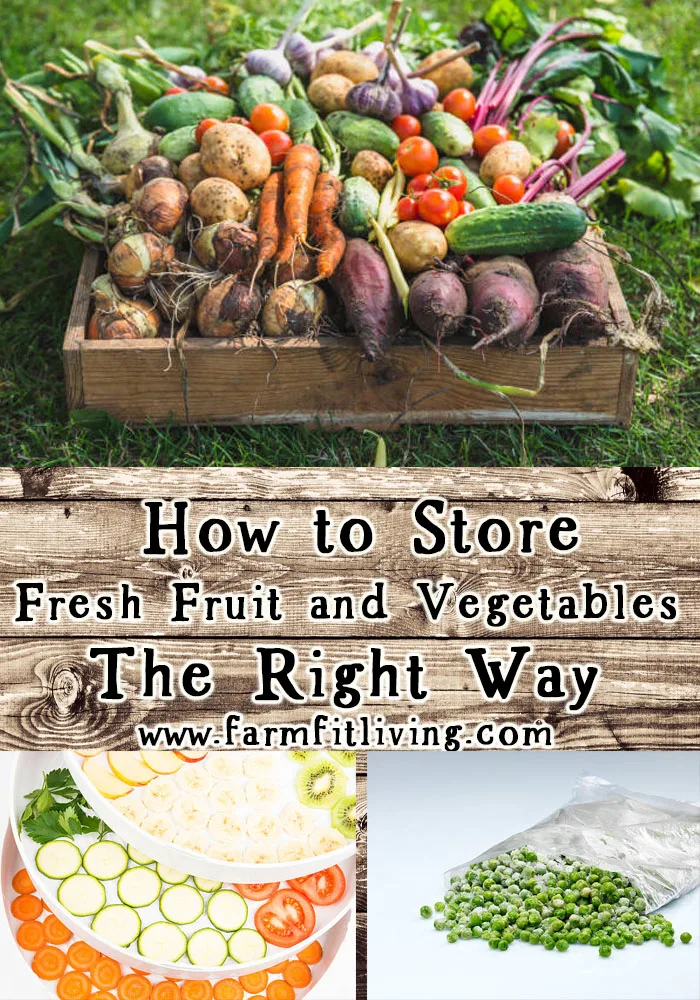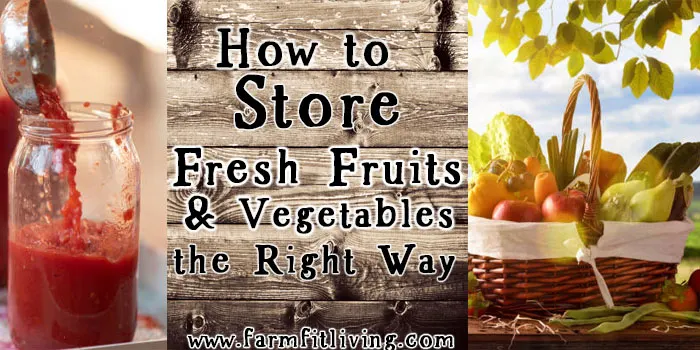Learn how to store fresh fruits and vegetables the right way.
Don’t ever let the fear of anything keep you from getting access to fresh fruits and vegetables. Knowing how to store fresh fruits and vegetables can really help you to stretch your produce to enjoy them longer.
Even if garden season seems months away, that should never stop you from having fresh fruits and vegetables on hand. However, when you are forced to stay home more to limit going out to the grocery store, how can you stretch your fruits and veggies and keep them for longer?
Today, I’m going to:
– Share about specifically storing, freezing, dehydrating and canning fruits and vegetables to make them stretch longer for you.
– Provide tips for safely storing, preserving and using up your fresh produce. Be prepared to be amazed.
Listen to the Podcast:
This post contains Affiliate Links. This means if you click and buy, I might make a commission at no cost to you.
See my policy for more information

How to Store Fresh Fruits and Vegetables
First of all, I want to talk to you about storing. We all love enjoying our fruits and vegetables fresh, right? And sometimes freezing and dehydrating can affect the taste and it may not feel like you’re eating anything fresh. So I have some tips for you on how to store fresh fruits and vegetables the right way.
You might run home from the store or from the market and throw everything in the fridge. Well, to be honest, there are certain things that really shouldn’t go in the fridge. I’m going to distinguish and give you a list that kind of breaks all these items up on what should go on the fridge and what should stay at room temperature.
Vegetables and fruits stored at room temperature:
- Bananas
- Basil
- Cucumbers
- Eggplant
- Garlic
- Grapefruit
- Green beans
- Lemons
- Limes
- Onions
- Oranges
- Potatoes
- Summer squash
- Sweet potatoes
- Watermelon
- Winter squash
- Zucchini.
Those are all items that you should store in room temperature.
Store on Countertop but Move to Fridge When Ripe:
Now, these are the items that you should store on your countertop at room temperature first. But then when they are ripe, you should check them. When they turn ripe, kind of squishy, then you should move them to the refrigerator. You can stretch them a little longer that way.
- Apricots
- Avocados
- Kiwi
- Mangoes
- Melons
- Nectarines
- Papayas
- Peaches
- Pears
- Pineapple
- Plums
Always store these in the fridge:
- Apples
- Asparagus
- Blueberries
- Corn on the cob (In the husk)
- Broccoli
- Brussel sprouts
- Cabbages
- Carrots
- Cauliflower
- Cherries
- Cilantro
- Dark leafy greens
- Grapes
- Leeks
- Lettuce
- Parsley
- Peas
- Pomegranates
- Raspberries
- Strawberries
Food Prep with Fresh Fruit and Vegetables
Now, what if you do a food prep? You bring home your produce and slice them up ahead of time for snacking. The kids are home and they are going to need some healthy snacks.
Most fruits will last about 7 days after being sliced and stored in an air tight container in the refrigerator. Always keep freshly sliced produce in the fridge in an airtight container. Obviously, some fruits such as apples, bananas and avocado are not the best for slicing ahead of time because they brown quickly. You can store these whole in your crisper drawer inside your fridge. The crisper keeps the moisture in check, which adds longevity to your produce.
Now let’s talk about washing. You definitely want to try to wash your produce when you get it home, if not before first use. However, you want to be careful to make sure that your produce is dry before actually storing it. Set it out on the table top on a towel and just let it dry before you put it into storage.
Freezing Fruit & Vegetables
So, we’ve talked about the basic storing techniques for fruits and vegetables. Now what happens when they’ve reached that week to two week limit and you still haven’t enjoyed them yet? Maybe you bought too much or maybe you’re just not hungry for that certain fruit or vegetable right now.
Well you can always make it into a freezer recipe now. Then, you can stick it in the freezer and eat it later. A good example of that is like a broccoli casserole or something like that can be frozen and enjoyed later. Any kind of dessert can be frozen as well.
I love to make banana bread and banana muffins with our old bananas. It’s a really good way to use them up. We can make up a bunch and then stick it in the freezer.
Those are just some ideas on stretching your fruits and stretching those types of fruits and veggies. You can also blanch and freeze your fruits and veggies.
Most vegetables and fruits freeze very well.
For fruit you really don’t need to do that. You can just remove the skins, cut it up and then just place it into some freezer bags. Make sure to label them and then stick it in the freezer.
For vegetables such as peas, green beans, and carrots, I like to blanch them first. I blanch them in some boiling water and then immediately move them into a sink full of cold water. It keeps their color and their flavor actually very well.
Freezing fruit and veggies is really super easy and you can do it with a lot of different vegetables and fruits.
Dehydrating Fruits & Vegetables
Another way that you can preserve or stretch your fruits and vegetables is by dehydrating. I love dehydrating vegetables and fruits. I have a dehydrator, but I’ve also dehydrated in my oven on the lowest setting. Just set them on cookie sheets with parchment paper. Stick them in the oven and just let them dry for as long as you need.
The amount of time for dehydrating just simply depends on how much moisture the fruit or vegetable has in it. I’ve used my dehydrators and the oven to dehydrate fruit leather, fruits and vegetables. We love sweet potato chips and just regular potato chips dried. We love dried kale and dried green beans are really good. Dried onions are tasty as well.
Canning Fruits & Veggies
Last but not least is canning. We practice safe canning based upon science here at our house: Both water bath canning and pressure canning. Now keep in mind the difference, there are certain vegetables that should be water bath and certain vegetables that should be pressure canned.
It all depends on the pH of the vegetable. So, tomato products, whole tomatoes, anything like that can be water bath canned. Now if it’s any other vegetable: Corn, carrots, green beans, it needs to be pressure canned.
Always use safe recipes and safe time limits when deciding what you’re going to be canning. I like to use this recipe book for good safe canning recipes.
Canning is a huge learning curve. My grandma always was a canner. My mom always canned and so I grew up with it. I didn’t really start canning until I was married, but then I decided I really wanted to to start doing it for us and try to save a little money.
In the long run though, it’s a really good way that you can stretch your fruits and veggies. I mean basically you’re preserving the freshness of your vegetables and that is what is so awesome about about this.

Learning how to store fresh fruit and vegetables has Helped Us Prepare
Under the stay at home order due to the Corona virus in 2020, our stock pile of frozen, dehydrated and canned products reduced our trips to the grocery store. We actually started to use up whole tomatoes that were canned two years ago.
We made homemade spaghetti sauce for our daughter’s birthday. For this, we took out some jars of whole tomatoes from the 2018 crop year and we opened them and we made a delicious sauce. It was so good.
It was amazing because canned items are very limited at the grocery store during a pandemic. People were going to the store and just cleaning out the stores of everything that they could stock up on. So we were blessed to already have our stock pile on hand, even though we had no idea that anything like this was ever going to happened.
The main reason we have our stockpile is because we don’t like to waste good produce.
So canning, dehydrating, freezing, knowing how to store fresh fruit and vegetables has been a blessing to us. And that feeling of not wanting to waste anything has been good for us too.
I hope that this has helped you to understand how you can learn how to store fresh fruits and vegetables to enjoy them longer. These ways include freezing, dehydrating, and canning to preserve them because no one should ever be without fruits and vegetables in your diet.
And as the world gets a little more uncertain, there is definitely one thing you can count on. Fruits and veggies can be stretched. No one knows how long a pandemic is going to last. Nobody knows. But what we can know is that we can control how our fruits and veggies can be stretched for our own health and well being.
Wrap up
I hope this has helped you to do better and not waste so many fruits and vegetables. But to stretch the life of your vegetables and your fresh produce a little bit more.
Friend, if you know of somebody who needs to hear this message, please take the time and share it with your friend. If you never want to miss a single episode ever again, you can also subscribe and listen for free at:
– Apple Podcasts
– Spotify
– Podbean
– PlayerFM
– Deezer
Subscribe to the podcast and leave us a five star review. I would absolutely love that so much. It would help others who might be looking for topics like this to be able to find our podcast. It would share the podcast with more eyes and ears that need to hear our messages.
You know the message: You deserve to live and work the way you want to without the worry, without the fear and the overwhelm.
And that’s why I’m here today, my friend. To help and serve and teach you what I have learned to make your life a little bit easier and your time more manageable.
So my friend, thank you again so much for listening, especially while you’re stuck at home.


Interested in Canning?
Enter your email to receive Mindy's solutions to your canning questions and problems made simple. You'll get regular tips and announcements about exciting upcoming goodies that Mindy has in the works.

